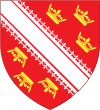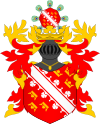Roman Catholic Archdiocese of Strasbourg
This article needs additional citations for verification. (June 2016) |
Archdiocese of Strasbourg Archidioecesis Argentoratensis o Argentinensis Archidiocèse de Strasbourg | |
|---|---|
Immediately subject to the Holy See | |
| Statistics | |
| Area | 8,280 km2 (3,200 sq mi) |
| Population - Total - Catholics | (as of 2017) 1,860,000 1,400,000 (75.3%) |
| Information | |
| Denomination | Catholic Church |
| Sui iuris church | Latin Church |
| Rite | Roman Rite |
| Established | 4th century (Diocese) 1 June 1988 (Archdiocese) |
| Cathedral | Cathedral of Notre Dame in Strasbourg |
| Patron saint | Saint Arbogast |
| Current leadership | |
| Pope | Francis |
| Archbishop | Pascal Michel Ghislain Delannoy |
| Auxiliary Bishops | Christian Kratz |
| Apostolic Administrator | Philippe Ballot |
| Bishops emeritus | |
| Website | |
| Official website | |
| Part of a series on |
| Alsace |
|---|
|
|
The Archdiocese of Strasbourg (
It is one of nine[
History
The Diocese of Strasbourg was first mentioned in 343, belonging to the
The bishop also was the ruler of an ecclesiastical principality (
Since the 15th century, the diocesan seat has been the
In 1871 the bulk of the diocese became part of
After World War I, Alsace along with the diocese was returned to France, but the status from the concordat has been preserved as part of the Local law in Alsace-Moselle.
The diocese was elevated to Archdiocese of Strasbourg on 1 June 1988 by
It enjoyed
On 27 May 2023, Pope Francis accepted the resignation of most recent Archbishop Luc Ravel.[2]
Cathedral and basilicas
The archiepiscopal cathedral seat is the Cathedral of Notre Dame (Our Lady) in Strasbourg, Grand Est, France, as mother church, a World Heritage Site.
It has four other
- Basilique du Sacré-Cœur (Sacred Heart) in Lutterbach, Haut-Rhin
- Basilique Notre-Dame de Marienthal, Bas-Rhin
- Basilique Notre-Dame de Thierenbach, in Jungholtz, Haut-Rhin
- Basilique Notre-Dame du Mont Sainte-Odile in Ottrott, Bas-Rhin.
Statistics
As per 2014, it pastorally served 1,380,000 Catholics (74.9% of 1,843,000 total) on 8,280 km² in 767 parishes and 5 missions with 722 priests (517 diocesan, 205 religious), 80 deacons, 1,332 lay religious (282 brothers, 1,050 sisters) and 17 seminarians . As of[update] 31 December 2003, the area of the archdiocese comprised a total of 1,713,416 inhabitants of which 75.9% (1,300,000) are Catholics, divided in 762 parishes covering an area of 8,280 km². Also, 619 diocese priests, 50 deacons, 288 ordained priests and 1,728 nuns belonged to the archdiocese.
Ordinaries
(Incomplete, first centuries unavailable)[3]
- Suffragan bishops of Strasbourg
- Amawich (Alavico) (999 – 1001.02.03)
- Werner de Bavière (Werner d’Asburgo) (1002 – 1028.10.28)
- Guillaume (Guglielmo, William) (1029 – 1047.11.07)
- Hermann (Wizelin) (1048 – 1065.01.15)
- Werner (Werner von Achalm) (1065–1079)
- Thiepald (Teobaldo) (1079–1084)
- Otton de Hohenstaufen (Otto von Büren) (1085 – 1100.08.03)
- Balduin (Baldovino, Baldwin) (1100–1100)
- Cunon (Conrad) (1100–1123)
- Bruno(n) (1123–1126)
- Eberhard (1126–1127)
- Bruno de Hohenberg (1129 – 1131.03.22)
- Gebhard (1131–1141)
- Burchard (1141 – 1162.07.10)
- Rodolphe (Rudof) (1162–1179)
- Father Conrad de Geroldseck (1179 – 1180.12.21)
- Henri de Hasebourg (1181 – 1190.03.25)
- Conrad de Hunebourg (1190 – 1202.11.03)
- Henri de Veringen (1202 – 1223.03.11)
- Berthold de Teck (1223–1244)
- Henri de Stahleck (1245 – 1260.03.04)
- Gautier de Geroldseck (1260 – 1263.02.12)
- Henri de Geroldseck (1263–1273)
- Father Conrad de Lichtenberg (1273 – 1299.08.01)
- Frédéric de Lichtenberg (1299 – 1306.12.20)
- Jean de Dirpheim (1306.02.18 – death 1328.11.06); previously Bishop of Eichstätt (Germany) (1305.09.23 – 1306.02.18)
- Berthold de Bucheck, Teutonic Order (O.T.) (1328.11.28 – 1353.11.25); previously Bishop of Speyer (Germany) (1328.05.07 – 1328.11.28)
- Jean de Lichtenberg (1353 – 1365.09.14)
- Jean de Luxembourg-Ligny (1366 – 1371.04.04)
- Lamprecht von Brunn (1371.04.28 – 1374.04.20), previously Bishop of Bamberg(Germany) (1374.04.28 – 1398)
- Frederik van Blankenheim (Frédéric de Blankenheim) (1375.07.05 – 1393.07.07); next Bishop of Basel (Switzerland) (1391.10.13 – 1393.07.07), Bishop of Utrecht (Netherlands) (1393.07.07 – death 1423.10.10)
- Father Ludovico di Thierstein (1393 not possessed)
- Father Burcardo di Lützelstein (1393–1394)
- Guillaume de Diest (1394 – death 1439.10.06)
- Rhosus(1428.11.29 – ?)
- Corrado di Busnang (1439 – 1440.11.11)
- Robert de Bavière (= of Bavaria) (1440 – 1478.10.18)
- Auxiliary Bishop: Hermann (1447 – death 1455), no other prelature
- Albert de Bavière (Calberto del Palatinato-Mosbach) (1478 – 1506.08.20)
- Guillaume de Hohnstein (1506 – 1541.06.29)
- Érasme de Limbourg (1541 – 1568.11.27)
- Jean de Manderscheid (1568 – death 1592.04.22)
- Apostolic Administrator Mr. Jean Georges de Brandebourg(1592 – retired 1604) no other office
- Cardinal S. Agata alla Suburra(1591.04.05 – death 1607.11.24)
- Auxiliary Bishop: Adam Petz (1605.07.18 – death 1626.11.26), Titular Bishop of Tripolis(1605.07.18 – 1626.11.26)
- Leopold V, Archduke of Austria (Leopold Erzherzog von Österreich-Tyrol, Mr. Léopold d’Autriche-Tyrol) (24 November 1607 - retired 19 April 1626), died 1632
- Wrocław (Breslau, Poland) (1656.01.21 – 1662.11.02)
- Auxiliary Bishop: Paulus Aldringen (born Luxemburg) (1627.04.28 – death 1644.03.28), Titular Bishop of Tripolis(1627.04.28 – 1644.03.28)
- Franz Egon Fürst von Fürstenberg (born Germany) (19 January 1663 - death 1 April 1682), previously Bishop of Metz(France) (1658 – 1663.01.19)
- S. Onofrio (1689.11.14 – 1704.04.10); previously Bishop of Metz(France) (1663.09.28 – 1668)
- Adrianopolis (1698.05.16 – death 1710.04.13); next Auxiliary Bishop of Diocese of Münster(Germany) (1699.08.14 – 1710.04.13)
- SS. Trinità al Monte Pincio(1721.06.16 – 1749.07.16)
- Auxiliary Bishop: Guillaume Tual (1715.02.04 – death 1716.02.24), Titular Bishop of Nyssa(1715.02.04 – 1716.02.24)
- Auxiliary Bishop: Louis Philippe d’Auneau de Visé (1719.01.08 – death 1729.06.26), Titular Bishop of Phessa (1718.03.14 – 1729.06.26)
- Auxiliary Bishop: Jean Vivant (1730.11.28 – death 1739.02.16), Titular Bishop of Parium (1730.11.28 – 1739.02.16)
- Auxiliary Bishop: Johann Franz Riccius (1739.10.11 – death 1756.05.12), Titular Bishop of Verinopolis (1739.10.11 – 1756.05.12)
- Cardinal-Priestbut with no Title assigned (1747.04.10 – 1756.06.28)
- Cardinal-Priestwith no Title assigned (1761.11.23 – 1779.03.11)
- Auxiliary Bishop: Toussaint Duvernin (1757.05.23 – death 1785.08.08), Titular Bishop of Arathia(1757.05.23 – 1785.08.08)
- Cardinal-Priestwith no Title assigned (1778.06.01 – death 1803.02.16)
- Auxiliary Bishop: Jean Jacques Lantz (1786.04.03 – death 1799.01.06), Titular Bishop of Dora(1786.04.03 – 1799.01.06)
- Auxiliary Bishop: Jean Jacques Lantz (1786.04.03 – death 1799.01.06), Titular Bishop of
- Jean-Pierre Saurine (9 April 1802 - death 7 May 1813)
- S. Sabina(1829.05.21 – 1844.01.01)
- Claude-Marie-Paul Tharin (23 August 1823 - 16 November 1826 Resigned), died 1843
- Jean-François-Marie Le Pappe de Trévern (13 December 1826 - death 27 August 1842), previously Bishop of Aire(France) ([1823.01.13] 1823.05.16 – 1827.04.09)
- Coadjutor Bishop: Bishop-elect Denis-Auguste Affre (1840.04.27 – 1840.05.26), Titular Bishop of Pompeiopolis (1840.04.27 – 1840.05.26); later Metropolitan Archbishop of Paris(France) ([1840.05.26] 1840.07.13 – 1848.06.27)
- Coadjutor Bishop:
- Andreas (André) Räß (Raess) (27 August 1842 - death 17 November 1887), succeeding as previous Rhodiopolis(1840.12.14 – 1842.08.27)
- Cæsaropolis(1881.05.13 – 1887.11.17)
- Pierre-Paul Stumpf (see above 17 November 1887 - death 10 August 1890)
- Adolf Fritzen (Fitzen) (24 January 1891 - retired 31 July 1919), emeritate as Mocissus(31 July 1919 – death 1919.09.07)
- Auxiliary Bishop: Charles Marbach (1891.06.04 – death 1901.09), Titular Bishop of Paphos(1891.06.04 – 1916.10.15)
- Auxiliary Bishop: Franz Zorn von Bulach (1901.10.24 – retired 1919), Titular Bishop of Erythræ (1901.10.24 – death 1925.01.13)[4]
- Charles-Joseph-Eugène Ruch (23 April 1919 - death 29 August 1945); previously Coadjutor Bishop of Gerasa(1913.06.14 – 1918.10.20), succeeding as Bishop of Nancy (1918.10.20 – 1919.04.23)
- Jean-Julien Weber, Archbishop ad personam(1962.03.25 – resigned 1966.12.30), died 1981
- Léon-Arthur-Auguste Elchinger (30 December 1966 - retired 16 July 1984), succeeded as former Coadjutor Bishop of Strasbourg ([1957.05.17] 1957.10.26 – 1966.12.30) and Titular Bishop of Antandrus(1957.10.26 – 1966.12.30); died 1998
- Pontifical Commission of Justice and Peace(1975 – 1976), Undersecretary of Pontifical Commission of Justice and Peace (1976 – 1977), Secretary of Pontifical Commission of Justice and Peace (1977 – 1980.03.27)
- Fréjus–Toulon (France) (1971.12.28 – 1976.11.18) and then as Auxiliary Bishop of Strasbourg (1976.11.18 – 1981.07.30), next exempt Archbishop of Monaco (Monaco) (1981.07.30 – 1984.07.16)
- Auxiliary Bishop: Léon Hégelé (1985.09.09 – retired 2000.12.18), Titular Bishop of Utica(1985.09.09 – death 2014.02.11)
- Archbishops of Strasbourg
- Archbishop-bishop Charles Amarin Brand(see above 1 June 1988 see promoted - retired 23 October 1997), also Vice-President of Council of European Bishops’ Conferences (1986 – 1990), President of Council of European Bishops’ Conferences (1990 – 1993); died 2013
- Joseph Pierre Aimé Marie Doré, Apostolic Administratorof Strasbourg (2006.08.25 – retired 2007.04.21)
- Jean-Pierre Grallet, O.F.M. (21 April 2007 - retired 2017.02.18); succeeded as previous Titular Bishop of Dardanus(2004.09.27 – 2007.04.21) and Auxiliary Bishop of Strasbourg (2004.09.27 – 2007.04.21)
- Auxiliary Bishop: Vincent Jordy (2008.09.19 – 2011.07.22), Titular Bishop of Idassa (2008.09.19 – 2011.07.22); next Bishop of Saint-Claude(France) (2011.07.22 – ...)
- France(2009.10.07 – 2017.02.18).
Gallery
-
Current (2017) archbishop Luc Ravel
-
Grand portal ofEpiscopal Palace
-
Secondary building of Episcopal Palace
-
TheMother Church: Strasbourg Cathedral
See also
References
- ^ Fouilles romaines sous l'église Saint-Étienne à Strasbourg (in French)
- ^ "Pope Francis accepts French archbishop's resignation". Duetsche Welle. 27 May 2023. Retrieved 28 May 2023.
- ^ "Archdiocese of Strasbourg". GCatholic.
- ^ Archivum Historiae Pontificiae: Vol. 18 (in German). Vol. 18. Gregorian Biblical BookShop. 1980. p. 372.
- Additional sources
- Herbermann, Charles, ed. (1913). . Catholic Encyclopedia. New York: Robert Appleton Company.






